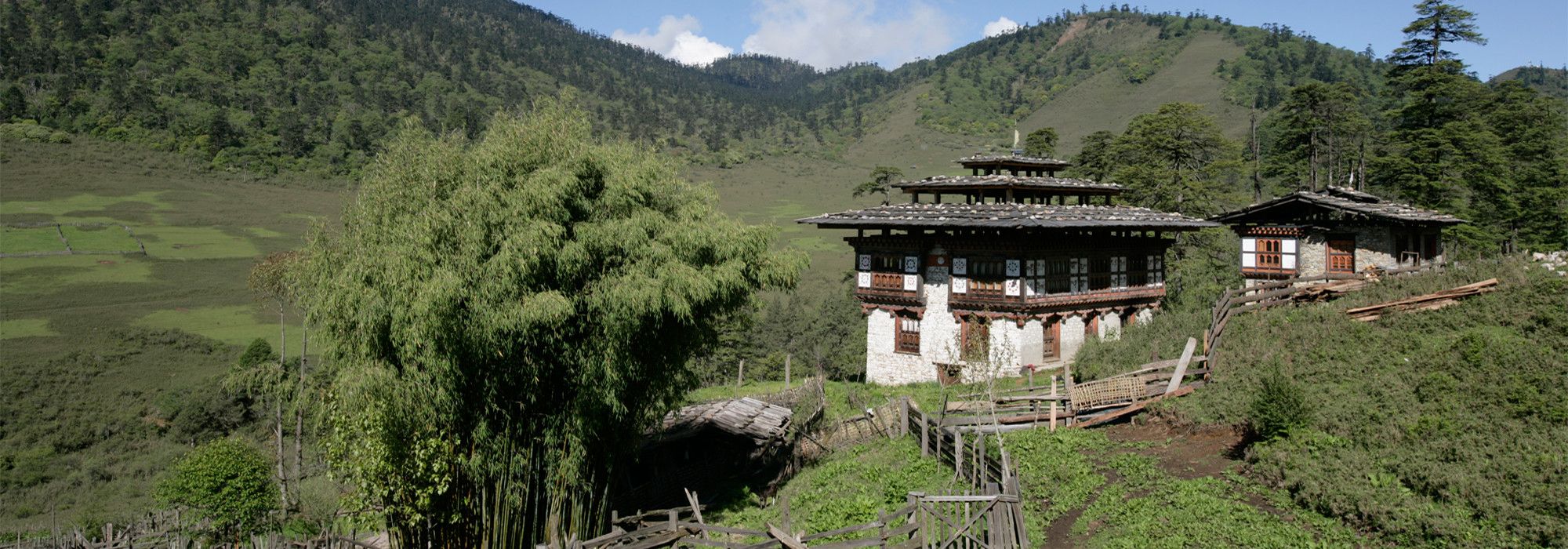
Chali Village
Overview
One day excursion. Distance from Mongar: 30 minutes on paved road. Hiking time: several hours over course of day at Level 2-3. A new farm road will soon bring visitors (who choose not to climb) to the lhakhang. They can either walk or drive down at the end of the day. Elevation: 1421 meters at geog center About a 30 minute drive from Mongar on the paved road to Lhuentse, visitors can stop at Thalapang and climb 1.8 km up to reach the first of many stops along the day’s route, Dechencholing Lhakang. The ascent took 60 minutes to reach Chali. The village tour lasts as long as desired with another climb up to the geog (administrative) buildings and school, a distance of 1km straight up which takes another 40 minutes. Returning downhill (1.84 kms) in 50 minutes is quick according to most! Much of this is optional as the farm road nears completion.
Dechencholing Lhakang (monastery) was built by the third Karmapa Rangjung Dorje in the 14th century. Two temples were built in this geog (sub-district): this one which served as Karmapa’s winter residence, and a second, built by his disciple, a two hour climb higher which served as the
summer residence. The lhakhang is cared for by Gangtey Trelku, a lama and the 15 monks who live here and study under him. At the nearby goenpa, another 25 monks study with yet another master teacher. The monastery is 3 storeys high with one section remaining identical to its 14th century roots with relics, statues, and altar dating from this period. The most sacred statue was sculpted by the original lama who constructed the monastery. On the third floor, the quarters of the senior monk (who has his M.A. in Buddhism) another remarkable altar and the 108 volumes of Buddha’s original teachings can be viewed. One of the distinguishing features of this lhakang is the wall mural depicting the 1000 Buddhas and the stone with the original scripture of “on ma ni pad me hung” carved by the third Karmapa Rangjung Dorje himself. According to lore, if one can lift this very heavy stone over one’s head 9 times, their good fortune in life is guaranteed. The beauty of this tour was the glimpse into a local Bhutanese farmer’s life in addition to the visit of the magnificent monastery mentioned above and several distinctive chortens. Chali village, consisting of 270 households and 2,200 people, is typical of Bhutanese agricultural
society. Village life is rich and the locals invite the rare foreigner in for tea, Ara (home brewed wine), and lunch despite the fact that they have much less to eat than westerners. Their homes are old, characterized by rough hewn wooden planks used as shingles on roofs and stone walls with wooden windows with NO nails used anywhere (typical of Bhutanese style architecture). Ploughing the earth Farm land Along the narrow paths between village homes visitors will see the manufacture of corn chips (using old stone or wooden implements); fields being ploughed with oxen; men taking a break and playing Degor (a Bhutanese version of bocci or boules) where a round stone is thrown 30 meters to reach a target; soon to flower mango, orange, peach, guava, pomegranate, banana trees; chilli pepper and potato gardens; the brewing of Ara; an introduction to the health and geog administrative center, the natural resource extension center, and of course, the local village school. Here the children marvel at the sight of a new face and are as curious and friendly as their teachers and principal. If fortunate, young school children will perform traditional Bhutanese songs in dialect to the delight of peers and visitors. It is believed that the dialect spoken in Chali is one of the most difficult to understand. According to oral history, when God was distributing dialects throughout Bhutan, he ran out at Chali. To solve the problem, he placed all the remnants of the various dialects into a sack, shook it up and gave the village of Chali this hard-to-understand dialect. When Chali villagers speak, their words are recognizable to Bhutanese from across the country.
Commentary A visit to Chali or another similar village is the kind of tourism that brings one infinitely closer to the heart of Bhutanese life. Bhutan boasts 80% of its population as rural/agricultural. It has a unique and progressive conservation policy that dictates that the country remains 60% forested at all times, regardless of the economic advantage it might bring if the trees were exported. This daylong excursion enables the observer to grasp the essence of Bhutanese life in a rural, somewhat remote village.
